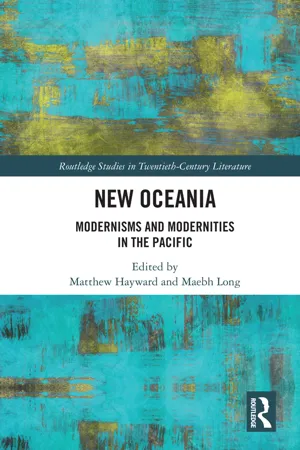
New Oceania
Modernisms and Modernities in the Pacific
- 270 pages
- English
- ePUB (mobile friendly)
- Available on iOS & Android
New Oceania
Modernisms and Modernities in the Pacific
About This Book
For so long figured in European discourses as the antithesis of modernity, the Pacific Islands have remained all but absent from the modernist studies' critical map. Yet, as the chapters of New Oceania: Modernisms and Modernities in the Pacific collectively show, Pacific artists and writers have been as creatively engaged in the construction and representation of modernity as any of their global counterparts. In the second half of the twentieth century, driving a still ongoing process of decolonisation, Pacific Islanders forged an extraordinary cultural and artistic movement. Integrating Indigenous aesthetics, forms, and techniques with a range of other influences — realist novels, avant-garde poetry, anti-colonial discourse, biblical verse, Indian mythology, American television, Bollywood film — Pacific artists developed new creative registers to express the complexity of the region's transnational modernities. New Oceania presents the first sustained account of the modernist dimensions of this period, while presenting timely reflections on the ideological and methodological limitations of the global modernism rubric. Breaking new critical ground, it brings together scholars from a range of backgrounds to demonstrate the relevance of modernism for Pacific scholars, and the relevance of Pacific literature for modernist scholars.
Frequently asked questions
Information
1 ‘The Space Between’: Oceanian Literature and Modernist Studies
Table of contents
- Cover
- Half Title
- Series
- Title
- Copyright
- Dedication
- Contents
- List of Figures
- List of Contributors
- A Note on Language and Spelling
- Acknowledgements
- 1 ‘The Space Between’: Oceanian Literature and Modernist Studies
- 2 ‘Kidnapped by a Band of Western Philosophers’: Modernism and Modernity in Oceania
- 3 ATOMic Modern: Pacific Women’s Modernities and the Writing of Nuclear Resistance
- 4 No Ordinary Modernism: Hone Tuwhare’s First Book of Verse
- 5 ‘Our Own Identity’: Albert Wendt, James Joyce, and the Indigenisation of Influence
- 6 Mapping Modernity in Guam: The Unincorporated Ecologies of Craig Santos Perez’s Poetics
- 7 Africana Calls, Pasifika Responses: Ellison’s Invisible Man, Soaba’s Wanpis, and Oceanian Literary Modernism
- 8 Oceanian Modernism and the Little Magazine
- 9 ‘[Modernism] in Māori Life’: Te Ao Hou
- 10 Emergent Modernities in Pacific Theatre: Nina Nawalowalo and The Conch
- 11 Diving-Dress Gods: Modernism, Cargoism, and the Fale Aitu Tradition in John Kneubuhl’s ‘The Perils of Penrose’
- 12 Oceanian Knowing and Decolonial Love in Sia Figiel’s Freelove
- 13 On Memory and Modernity: Sudesh Mishra’s Oceania
- 14 Oceania, the Planetary, and the New Modernist Studies: A Coda
- Index